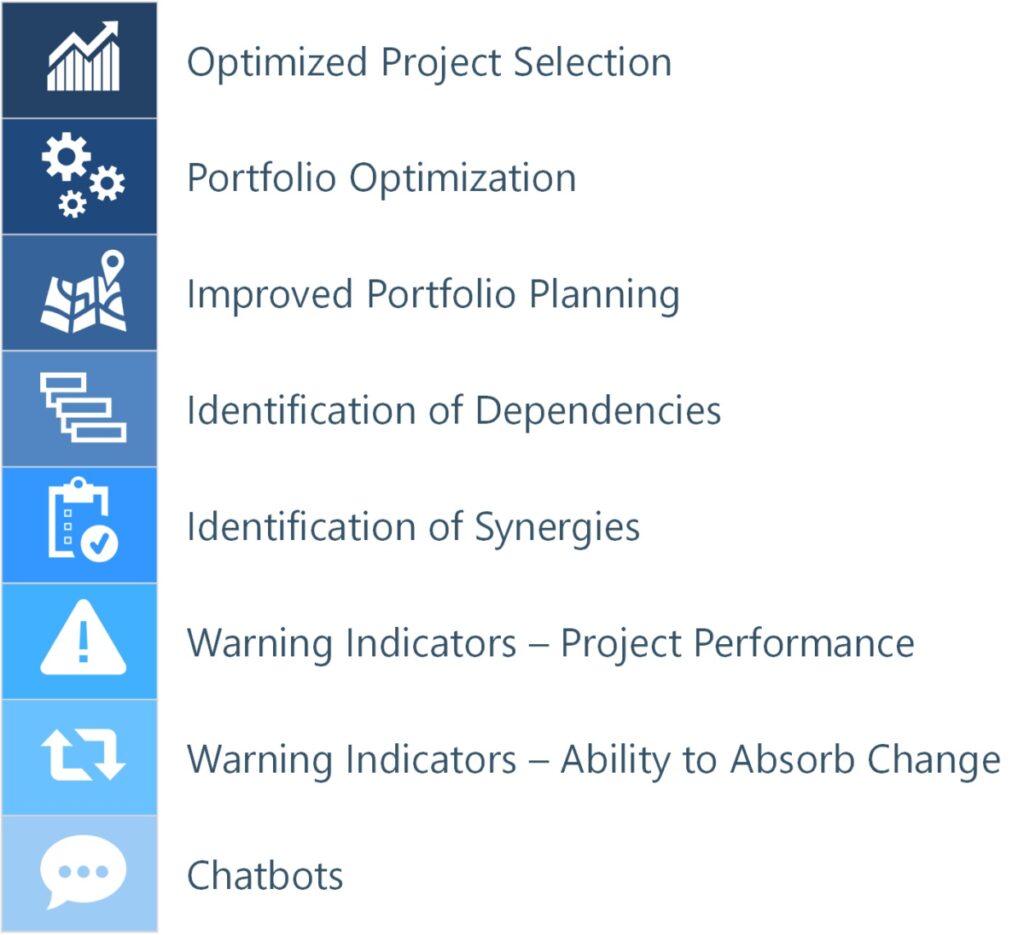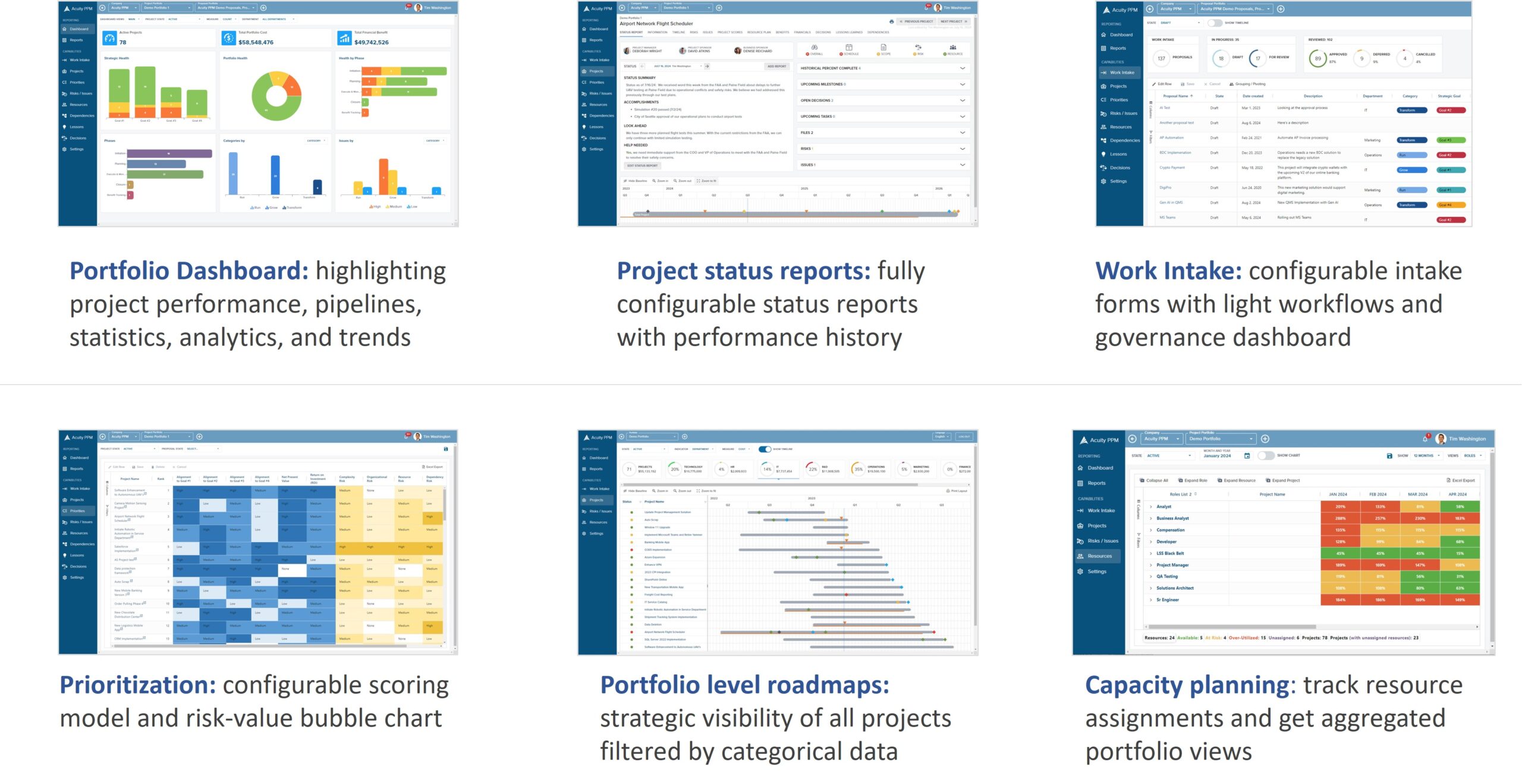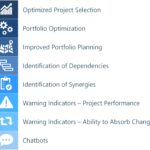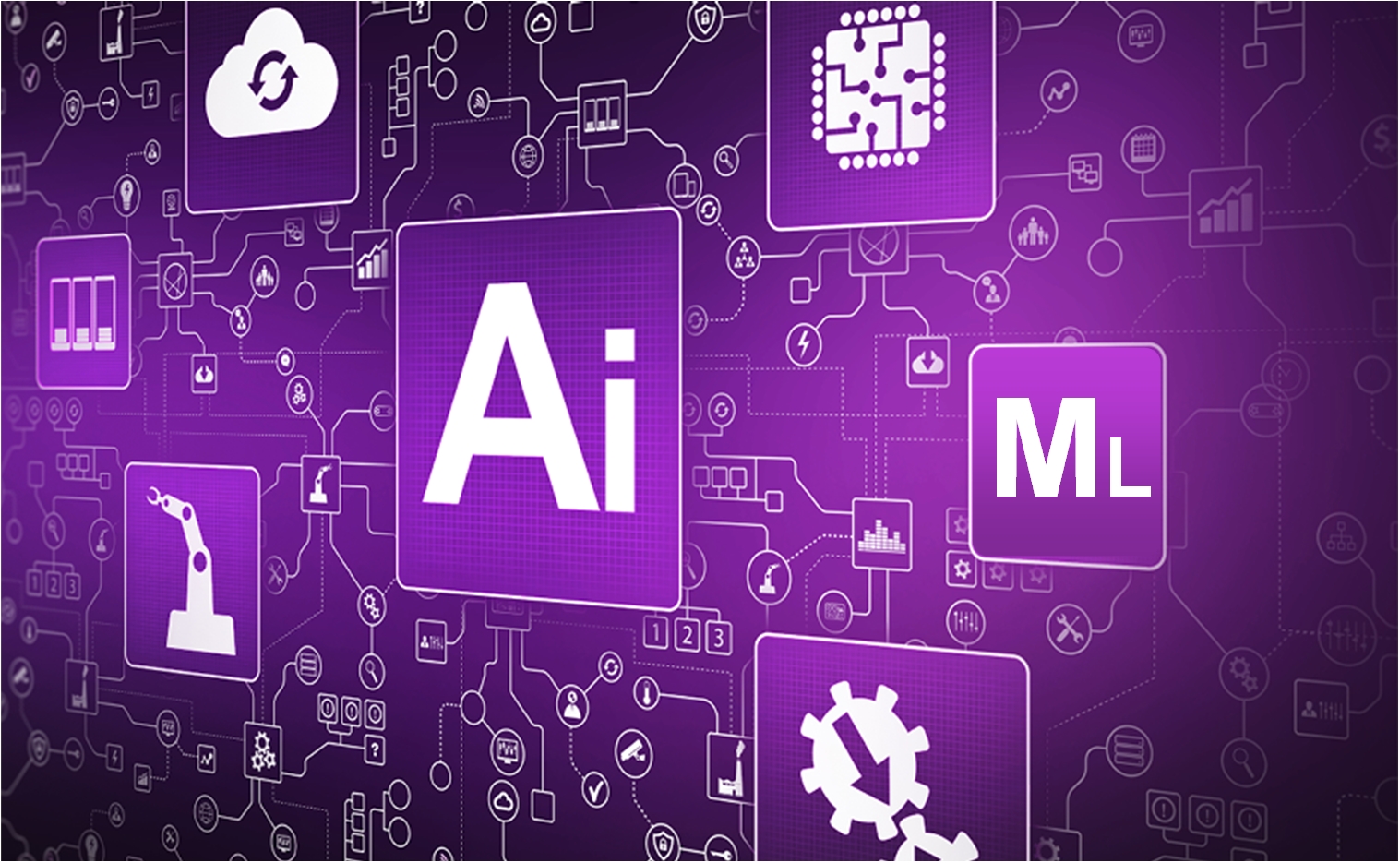How Artificial Intelligence (AI) Will Change Project Portfolio Management
There is no question that we are in the midst of radical changes to our workplace and society due to the mainstream emergence of Artificial Intelligence (AI) and Machine Learning (ML). Experts have been predicting for several years how AI will change the way we work. With the public arrival of ChatGPT at the end of 2022, these changes are accelerating and organizations need to be ready sooner (not later) to begin utilizing this technology to improve work. While there has been some research into how Artificial Intelligence (AI) and Machine Learning (ML) will change project management, there has been far less consideration for how these technologies will affect project portfolio management (PPM). One of the best articles to come out on how AI and Machine Learning will affect project and portfolio management is a recent Harvard Business Review article by Antonio Nieto-Rodriguez and Ricardo Viana Vargas titled “How AI Will Transform Project Management”. In this article, the authors address the changes coming to project management but also touch on some important elements affecting project portfolio management (PPM). In this post, we will expand further on some of these key points and hone in on the technology changes that will impact portfolio management.
According to the article by Nieto-Rodriguez and Vargas “Gartner’s research indicates that change is coming soon, predicting that by 2030, 80% of project management tasks will be run by AI, powered by big data, machine learning (ML), and natural language processing….When this next generation of tools is widely adopted, there will be radical changes.” The purpose of this article is to help you prepare for these major changes that are coming soon.
Opportunities for Artificial Intelligence (AI) in PPM
The first major section of this post will cover the significant opportunities coming to help organizations improve project portfolio management (PPM).

Optimized Project Selection
From a decision-making standpoint, the biggest challenge senior leaders face is project selection. The problem is less about selecting the right projects and more about selecting too many projects. Selecting more projects than the organization can realistically take on is one of the major root causes of project management deficiencies today. I have rarely seen a company that truly understands its own resource capacity and authorizes projects according to its capacity. Rather, the needs and demands of the business far exceed its people’s availability to get work done. Rather than make hard decisions and say “no” or “no, not right now”, many companies simply authorize more project work and ask their people to “find a way” or “just one more project”. This thinking can cripple an organization’s ability to successfully deliver projects. It doesn’t matter how good your Project Managers are, if you overload the organization with more work than they can handle, things will fall through the cracks, deadlines will be missed, mistakes will be made, etc. The Work Intake process is one of the most critical steps in all of project portfolio management because it is the front door to the portfolio. Now, Artificial Intelligence (AI) and Machine Learning (ML) have the opportunity to radically change how Work Intake and project selection are performed.
Most senior leaders suffer from having a project-centric focus rather than a portfolio-centric focus. AI and Machine Learning don’t have this problem. These tools help remove human biases from decision making and can take in vast amounts of data to help inform better decision making. Rather than simply evaluating whether a single project is a worthwhile investment, Artificial Intelligence (AI) and Machine Learning (ML) can look at all the available data for active projects, completed projects, cancelled projects as well as all the ideation data and other proposals to help compare a single proposal against the full history of available project data. Artificial Intelligence (AI) and Machine Learning (ML) can utilize that data and provide recommendations whether the project should be selected, how valuable the proposal really is, and even include a likelihood of success based on historical data. These recommendations alone would improve the upfront intake of project work and help Senior Leaders make better decisions by understanding a single project in the context of the entire portfolio. Fortunately, we can even take this a step further.
Portfolio Optimization Finally Becomes Reality Thanks to Artificial Intelligence (AI)
Project portfolio optimization has long been a theoretical concept for most organizations utilizing project portfolio management (PPM) because it is simply too complicated and too advanced. On paper, the concepts are sound, but in practice, portfolio optimization requires the right people to do optimization analysis and a leadership team that buys into the results (more on this later). Artificial Intelligence (AI) and Machine Learning (ML) have the capability to perform true optimization analysis behind the scenes and generate options for Senior Leaders to choose from that will optimize portfolio value. Inputs such as: value scores, risk scores, net present value, project duration, scope complexity, team size, resource risks, can all be utilized to generate more optimal portfolios than most Portfolio Managers can generate on their own. In this case, Artificial Intelligence (AI) and Machine Learning (ML) are not costing any jobs within the Project Management Office (PMO), these technologies are simply filling in the gap. Most organizations neither have the right data nor the right skills to conduct portfolio optimization. Artificial Intelligence (AI) and Machine Learning (ML) will soon be available to augment the PMO with needs that previously went unmet. As discussed in our post on portfolio optimization, we highlighted that foundational processes form the basis of advanced processes. Now with AI and Machine Learning, organizations have a realistic opportunity to incorporate more advanced portfolio management practices.

Artificial Intelligence (AI) and Machine Learning (ML) will not only help with cost-value optimization but will also support resource optimization as well. Imagine creating a resource plan and receiving a list of recommended resources in order to create the initial resource plan. Or, AI and ML could provide recommendation to augment the project team with additional staff based on historic resource plans. AI and ML could also help identify under-staffed projects and recommend additional team members in order to support a realistic project plan that will increase its likelihood of success and deliver on time.
Improved Portfolio Planning
As covered in a previous post, portfolio planning synthesizes priority data with resource data to help optimize the timing of projects in order to drive strategy execution and higher portfolio value. Much of this is based on a company’s strategic plan and portfolio planning helps translate strategic goals to a tactical level that is realistic to achieve.
Just as with project portfolio optimization, Artificial Intelligence (AI) and Machine Learning (ML) will greatly help PMO’s and Portfolio Managers put together a more realistic portfolio plan. Typically, even if the right projects are selected, virtually all of these approved projects go straight to project execution. This is another problem that AI will help address. Today, portfolio planning requires a significant amount of analysis to understand future resource availability and take into account relative priorities in order to sequence projects at the right time. Artificial Intelligence (AI) and Machine Learning (ML) will be able to conduct this analysis behind the scenes to make recommendations as to when to initiate certain types of projects. Over time, probability analysis will likely include success rates, estimated duration and estimated completion dates, etc.
Identification of Dependencies
Another potential of Artificial Intelligence (AI) and Machine Learning (ML) is related to identifying project interdependencies. Most organizations do not have a habit of identifying and mapping project dependencies, but project dependencies represent a potential risk factor for successful project management. Identifying these dependencies in the early stages of initiation and planning give Project Managers enough time to coordinate with the Project Managers of the dependent projects in order to mitigate against any negative impacts in the future. There are different types of dependencies such as technical dependencies, resource dependencies, synchronization dependencies, and even information dependencies. Over time, Artificial Intelligence (AI) and Machine Learning (ML) will be equipped to identify potential project dependencies between projects and bring it to the attention of the impacted Project Managers as well as Portfolio Manager(s).
Identification of Synergies
In a similar way to identifying project dependencies, AI and ML will further be able to support project selection by identifying proposals that have potential synergies with other projects and proposals. This will further enhance the project selection process. Organizations that have an ideation process may have dozens or hundreds of ideas in a backlog waiting to become formal proposals. Or, there may be other proposals that were deferred for the future but are forgotten. The challenge is that the best ideas move forward in the moment, but other ideas that may not have been technically feasible or cost prohibitive get forgotten. After a period of time, these ideas and proposals may be worth revisiting, but most PMO’s and Portfolio Managers don’t have the time to do holistic analysis of all these ideas to help propose new projects. In the future, PMO’s and Portfolio Managers will be able to take advantage of Artificial Intelligence (AI) and Machine Learning (ML) so that groups of ideas and proposals when put together form a compelling project or program worth doing. This will further leverage the collective intelligence of the company as well as boost morale by selecting good proposals that may have otherwise been forgotten.
Early Warning Indicators at the Portfolio Level
Artificial Intelligence (AI) and Machine Learning (ML) will also bring about major improvements to project execution (from a portfolio perspective) by providing early warning indicators to Project Managers, PMO’s, Portfolio Managers, and Project Sponsors related to project performance as well as an organization’s ability to absorb change.
Project Performance
Artificial Intelligence (AI) and Machine Learning (ML) provide an opportunity to more fully utilize historical project performance and combine that with risk data, issue data, resource data, priority data, schedule data, and prioritization data to help predict future project performance. This could be utilized up front during Work Intake or project initiation to help inform the likelihood of success for a project. Or it could alert a project team that more people, time, or budget will be needed to complete the project based on past project performance. For projects in flight, certain key words in a status report or risk log could trigger early warnings to a Project Sponsor or PMO Director that a certain project may be in trouble in the future and give them time to work with the Project Manager. After enough learning, it may be possible to predict different likelihoods of success based on team composition. In other words, the predictive analytics may be strong enough to indicate whether one Project Manager will be more or less successful on the same project as another Project Manager.
An Organization’s Ability to Absorb the Change
In the book Project Portfolio Management: A View from the Management Trenches, one of the chapters asks a simple yet enlightening question “can we absorb all the changes?” Most organizations do not consider how many changes come to their teams throughout the year based on project delivery. New IT implementations, new processes or trainings are coming at employees regularly. While companies need to adapt to changing customer and market needs, sometimes the timing of certain projects will coincide with other projects resulting in a lot of change all at once to internal or external customers that could be detrimental for adoption of new processes and tools. As another way of providing early warning indicators, Artificial Intelligence (AI) and Machine Learning (ML) will help analyze the timing of project completions, the impacted organizations, and the level of change expected in order to support organizational change management and improved communications. In some cases, certain projects may need to be delayed (or accelerated) in order to avoid the collision of multiple projects completing at the same time.
PPM Chatbot
The last major opportunity for Artificial Intelligence (AI) and Machine Learning (ML) in this post relates to the use of chatbots. Chatbots are already available in many software packages today, but chatbots in the near future will be far more conversational and will do more than simply collect data or provide a link to articles to answer questions. PPM chatbots will be able to better questions around how to use project and portfolio management software as well as provide direct answers on how to carry out portfolio management processes.
Preparation Needed for Artificial Intelligence (AI) and Machine Learning (ML) to Be Effective
This next section is brief but critical and focuses on what organizations need to do right now to prepare for the benefits of Artificial Intelligence (AI) and Machine Learning (ML). None of the benefits discussed earlier will be possible for organizations if they do not have the critical piece – structured data.

The Critical Ingredient – Structured Data
The problem for many organizations today is that too much of their project and portfolio data is unstructured, meaning that it exists in different places (ie. Spreadsheets, Word documents, various SharePoint sites, Teams channels, or disparate project management tools). To make things worse, many companies do a poor job of storing historical data; there is no central repository that exists. This is problematic especially when key Project Managers leave the company, a lot of that data simply gets lost. Furthermore, even if there is a reasonable amount of data available, a significant amount of data cleanup will likely be required.
“When these tools are ready for organizations, how will you make sure your organization is ready for them? Any AI adoption process begins with data, but you must not fail to prepare your people as well. Training AI algorithms to manage projects will require large amounts of project-related data. Your organization may retain troves of historical project data, but they are likely to be stored in thousands of documents in a variety of file formats scattered around different systems. The information could be out-of-date, might use different taxonomies, or contain outliers and gaps.”
-Nieto-Rodriguez and Vargas
As promising as Artificial Intelligence (AI) and Machine Learning (ML) are to improving project portfolio management (PPM), none of it matters if an organization does not have an adequate amount of clean structured data. This brings us to a very important consideration for preparing for AI and Machine Learning.
How a Solution Like Acuity PPM Will Help You Prepare for Artificial Intelligence (AI) and Machine Learning (ML)
Utilizing good project portfolio management software can greatly improve the quality of your data, provide a central location for key project data, and prepare your organization for the benefits of Artificial Intelligence (AI) and Machine Learning (ML).
A solution like Acuity PPM is already preparing for the AI and ML benefits shown above. If you are stuck in spreadsheets and SharePoint sites, Acuity PPM will help you structure your data and provide the repository you need to take advantage of AI and ML in the future. Our solution incorporates Work Intake, prioritization, and resource capacity planning and already stores the full history of status reports, risk and issue logs, financial data, and lessons learned. Even if you are not yet ready to utilize this technology, moving to a solution like Acuity PPM will save you time in the future and make it easier to adopt the benefits of AI and ML.

“Roughly 80% of the time spent preparing a ML algorithm for use is focused on data gathering and cleaning, which takes raw and unstructured data and transforms it into structured data that can train a machine learning model.”
-Nieto-Rodriguez and Vargas
The Change Required to Benefit from Artificial Intelligence (AI) and Machine Learning (ML)
In this last major section, we highlight some important questions that senior leaders need to be able to answer before their organizations can really take advantage of Artificial Intelligence (AI) and Machine Learning (ML) in support of project portfolio management (PPM). The questions below are adapted from the article by Nieto-Rodriguez and Vargas.
- Are you willing to invest the time and energy needed to create an accurate inventory of all your project data including the status updates?
As discussed above, having clean structured data is paramount to enjoying the benefits of Artificial Intelligence (AI) and Machine Learning (ML). If you rely on spreadsheets for project and portfolio data and do not have a good inventory of your data in a central location, now is the time to correct that deficiency. Companies that fail to have a central repository of data will fall further and further behind in terms of the value of AI and ML.
- Will you invest resources for several months to gather, clean, and structure your project data?
The answer to this question really determines the willingness to embark on an AI/ML journey with project and portfolio management. Having the right people available to do the work will determine whether your organization has the right data at the right time.
- Is your organization prepared to invest in training the project management community in AI/ML technology?
New technology can bring fear and caution, especially with tools like Artificial Intelligence (AI) and Machine Learning (ML) that have the potential to cut jobs. Leadership would benefit by attending AI/ML training with their PMO to understand how AI and ML will support project and portfolio management in the future.
- Is your organization ready to accept and adopt AI/ML technology and “hand over the reins on decisions” with increasingly higher stakes?
This question is directly centered at the leadership team themselves and changing their behaviors (i.e. the way they make decisions). The leadership team or governance team will have to have a certain level of comfort with the information and recommendations provided by the AI/ML algorithms. Otherwise, it is all talk and no action. If the governance team simply wants to receive new data only to ignore it, then it is better to wait on utilizing AI/ML technology until a group of leaders are in place to embrace it. Many of the benefits listed above relate to new insights to help leaders make better decisions. In the case of portfolio optimization, the recommendations do help support project selection, but they mainly help inform governance teams which projects not to do (which is a common problem today).
- Is your leadership team ready to let AI/ML technology make mistakes as it learns to perform better for your organization? And wait up to one year to start seeing the benefits of AI/ML technology?
AI and ML are tools to support strategic decision making, not replace the decision makers themselves. The algorithms will need time to get calibrated and the leadership team plays an important role in that calibration. We are just at the beginning of utilizing AI/ML technology on a broader scale and leadership teams will become more familiar with how to train AI/ML algorithms. However, this means that AI/ML algorithms will make mistakes. From a change perspective, senior leaders need to set the correct expectations that it will take time in order to train (and therefore trust) the recommendations delivered through AI/ML technology.
- Do you have an executive sponsor with the capability and credibility to lead this transformation?
Having the right executive sponsor who understands the organizational change process as well as the requirements of Artificial Intelligence (AI) and Machine Learning (ML) will be able to properly communicate and set expectations to the executive leadership team (ELT) as well as the rest of the company. Undoubtedly, AI/ML technology will create discomfort at higher levels of management and the road to AI/ML benefits may be bumpy. Those companies with a strong executive sponsor will be better positioned to successfully utilize Artificial Intelligence (AI) and Machine Learning (ML).
Summary of How Artificial Intelligence (AI) and Machine Learning (ML) Will Impact Project Portfolio Management (PPM)
The AI project management revolution has begun. Artificial Intelligence (AI) and Machine Learning (ML) have already started shaking up various industries (education being one) and is not going away. Through tools such as ChatGPT, we are just beginning to see the possibilities of how AI and ML will change the way we work. PMO Leaders must ready their teams to take on these new technologies in order to improve project management and portfolio management. In this post we highlighted some of the exciting opportunities for AI and ML to improve portfolio decision making on several levels as well as consume vast amounts of data to help provide early warning indicators around project performance. One of the biggest takeaways is that PMO Leaders must have a system of record with vast amounts of clean and structured data in order to take advantage of AI and ML in the near future. The time to prepare is now; and tools such as Acuity PPM will put organizations ahead of the curve in preparing for AI and ML adoption.
Tim is a project and portfolio management consultant with over 15 years of experience working with the Fortune 500. He is an expert in maturity-based PPM and helps PMO Leaders build and improve their PMO to unlock more value for their company. He is one of the original PfMP’s (Portfolio Management Professionals) and a public speaker at business conferences and PMI events.
[activecampaign form=3]
How will AI change portfolio management?

Specifically to project portfolio management, we see at least eight changes coming: optimized project selection, portfolio optimization, improved portfolio planning, identification of dependencies, identification of synergies, early warning indicators (project performance), early warning indicators (absorb change), and enhanced chatbots.
How can organizations prepare for AI and Machine Learning?
What changes do seniors leaders need to make to prepare for AI and Machine Learning?

Senior leaders firstly need to accept the uncertainty with making such as a change and then need to adjust how they make decisions by incorporating the feedback and recommendations from the AI/ML algorithm. The leadership team or governance team will have to have a certain level of comfort with the information and recommendations provided by the AI/ML algorithms. Otherwise, it is all talk and no action. Senior leaders also need to recognize that the algorithms will need time to get calibrated and the leadership team plays an important role in that calibration. This means that AI/ML algorithms will make mistakes. From a change perspective, senior leaders need to set the correct expectations that it will take time in order to train (and therefore trust) the recommendations delivered through AI/ML technology.
Is an executive sponsor necessary to lead this AI/ML transformation?

Having the right executive sponsor who understands the organizational change process as well as the requirements of Artificial Intelligence (AI) and Machine Learning (ML) will be able to properly communicate and set expectations to the executive leadership team (ELT) as well as the rest of the company. Undoubtedly, AI/ML technology will create discomfort at higher levels of management and the road to AI/ML benefits may be bumpy. Those companies with a strong executive sponsor will be better positioned to successfully utilize Artificial Intelligence (AI) and Machine Learning (ML).
Never miss an Acuity PPM article
Don't take our word, listen to what others are saying:
"I find value in all of your articles."
"Your articles are interesting and I am sharing them with my team who have limited project knowledge. They are very useful."



